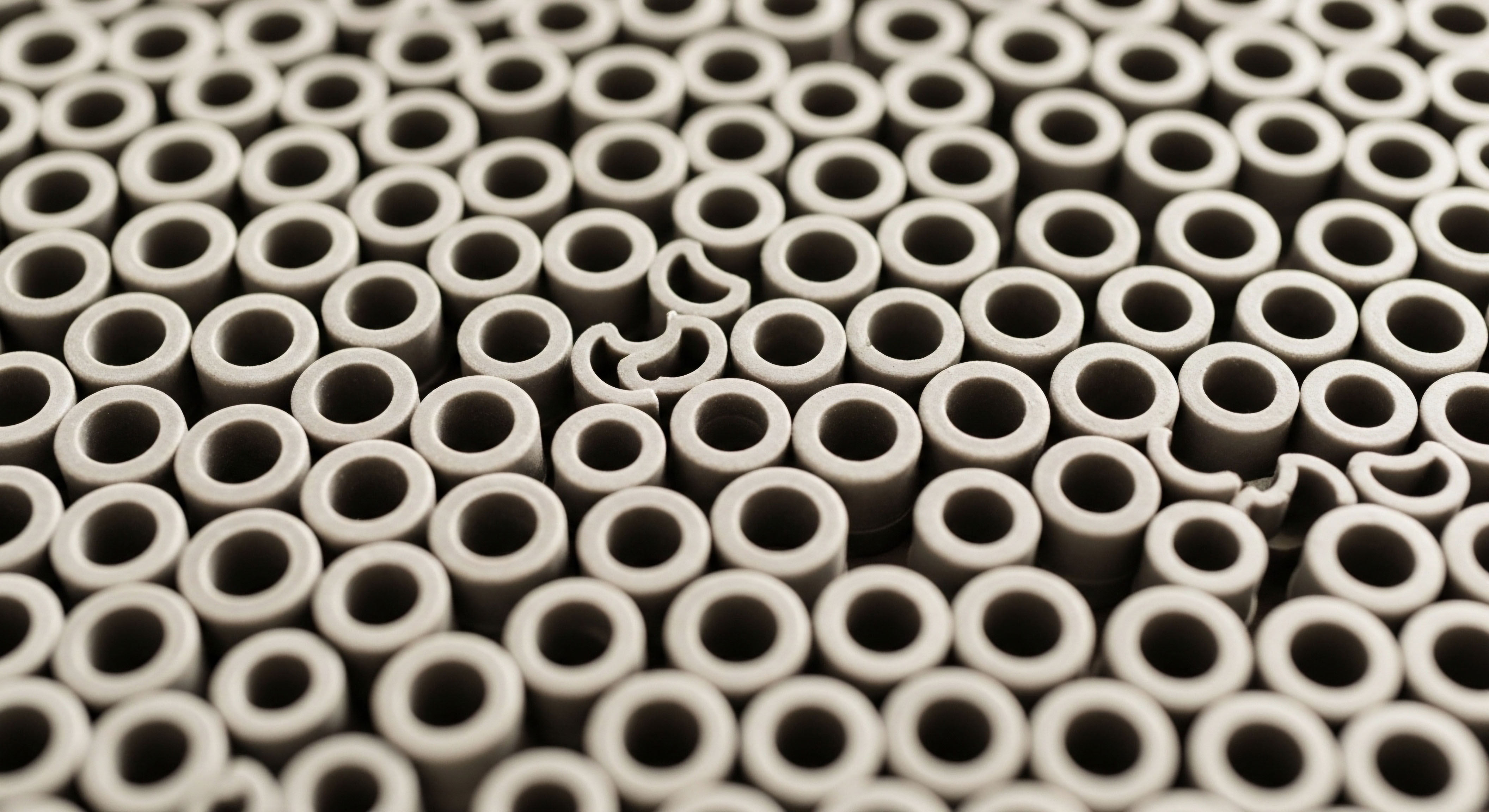

Fundamentals
You feel it in your body. A change in resilience, a subtle shift in how you recover, or perhaps a frank conversation with your physician has brought the concept of bone health to the forefront of your mind. This conversation often begins with a feeling, a personal, lived experience of your body’s changing capacity.
Your skeletal system is a living, dynamic diary of your life. It meticulously records your nutritional choices, your patterns of movement, and the silent, powerful language of your hormones. Understanding the integrity of your bones is an exercise in understanding the story of your own biology. The efficacy of any protocol designed to support your skeletal framework is deeply intertwined with the daily lifestyle choices that write each new page of that story.
The strength of your bones is the result of a continuous, elegant process called remodeling. Picture two types of specialized cells working in a constant, coordinated dance. Osteoclasts are the deconstruction crew, breaking down old, tired bone tissue.
Following closely behind are the osteoblasts, the master builders, who lay down a new, strong, flexible matrix of collagen and then mineralize it, primarily with calcium and phosphate. For most of your early life, the builders work at a slightly faster pace than the deconstruction crew, leading to a net gain in bone mass.
This process is governed by a complex and sensitive network of hormonal signals. These biochemical messengers act as the conductors of this cellular orchestra, ensuring the balance between breakdown and rebuilding is perfectly calibrated to maintain skeletal strength.
Your skeletal framework is a dynamic, responsive tissue, constantly being rebuilt and remodeled under the direction of your hormonal systems.

The Hormonal Conductors of Bone Integrity
At the center of this regulatory network are the sex hormones, primarily estrogen and testosterone. These hormones are potent allies of your skeleton. Estrogen, in both women and men, acts as a brake on the osteoclasts, slowing the rate of bone breakdown. It also encourages the survival of the bone-building osteoblasts.
The steep decline in estrogen during menopause is what precipitates a rapid acceleration of bone loss in women, a key reason why skeletal health becomes a primary concern during this life transition. Testosterone plays a direct role in stimulating the activity of osteoblasts, promoting the formation of new bone.
A significant portion of testosterone in both sexes is also converted into estrogen within bone tissue itself, contributing to that crucial braking effect on bone resorption. The age-related decline of these hormones in both men and women removes these powerful protective signals, tipping the balance in favor of the deconstruction crew and leading to a gradual loss of bone density.
Other hormonal players are also essential. The parathyroid hormone (PTH) and calcitriol, the active form of vitamin D, work together to meticulously regulate calcium levels in the blood. When blood calcium is low, PTH is released, which stimulates osteoclast activity to release calcium from the bone ∞ your body’s calcium reservoir.
Calcitriol, on the other hand, promotes the absorption of dietary calcium from the intestine, ensuring the builders have the raw materials they need. Growth hormone and its downstream partner, Insulin-like Growth Factor-1 (IGF-1), are also powerful stimulators of osteoblast function, particularly during the years of peak bone mass accrual but continuing to play a supportive role throughout life.
The coordinated action of this entire hormonal team determines the strength and resilience of your bones from one moment to the next.

What Is the True Foundation of Bone Strength?
The conversation around bone health protocols, whether they involve hormonal optimization, targeted peptides, or nutritional strategies, must begin with an appreciation for this biological context. A protocol is a tool designed to restore a specific set of signals or provide essential building blocks. Its success, however, is not determined in a vacuum.
The environment in which that protocol operates ∞ an environment dictated by your lifestyle ∞ is what determines the magnitude of the outcome. A hormonal signal to build bone is only as effective as the availability of raw materials to do the building. A diet rich in calcium, vitamin D, vitamin K, and magnesium provides the physical components your osteoblasts need to construct a strong skeletal matrix. These nutrients are the bricks and mortar of bone.
Similarly, the physical forces exerted on your skeleton are a form of direct communication. Weight-bearing exercise and resistance training send a powerful, localized signal to your bones that says ∞ “More strength is needed here.” Every time a muscle pulls on a bone during a lift, or every time your body makes impact with the ground during a walk or a jump, it creates a stimulus that directly activates osteoblast activity.
This mechanical signaling is a fundamental requirement for maintaining bone density. Without it, even a perfectly optimized hormonal environment will fall short of its potential. Your lifestyle choices are the collaborators that work in concert with any clinical protocol, turning a therapeutic signal into a tangible, biological reality within your bones.


Intermediate
When we move beyond foundational concepts, we begin to appreciate the intricate mechanics of how lifestyle factors directly modulate the effectiveness of clinical bone health protocols. These protocols, whether they involve hormonal recalibration or the use of specific peptides, are designed to re-establish a pro-building state within the bone remodeling unit.
Their success is predicated on a biological environment that is receptive to these signals. Lifestyle factors are the primary drivers in creating this receptive state. They are not merely supportive; they are integral components of the therapeutic mechanism itself. We will examine the interplay between specific lifestyle inputs and the clinical strategies used to preserve and enhance skeletal integrity.

Nutritional Synergy with Hormonal Protocols
Hormone replacement therapies (HRT) for men and women are designed to restore the protective signaling that is lost with age. For a postmenopausal woman, replenishing estrogen levels can significantly slow the rate of osteoclast-mediated bone resorption, effectively preserving bone density.
For a man undergoing Testosterone Replacement Therapy (TRT), the goal is to restore testosterone’s direct anabolic effect on bone formation and provide a substrate for its conversion to bone-protective estrogen. These therapies provide the high-level command to protect the skeleton. Nutrition provides the logistical support and raw materials required to execute that command.
Consider the following key nutrients:
- Calcium This is the primary mineral that gives bone its hardness and compressive strength. Hormonal therapies can improve the body’s ability to incorporate calcium into the bone matrix, but they cannot create calcium. An inadequate dietary intake of calcium means the osteoblasts, despite being stimulated by testosterone or protected by estrogen, will lack the fundamental building block for mineralization. Protocols are amplified by a diet rich in dairy, fortified foods, and leafy greens.
- Vitamin D3 This fat-soluble vitamin is technically a prohormone. It is converted in the liver and then the kidneys into its active form, calcitriol. Calcitriol’s primary role is to enhance calcium absorption from the gut. Without sufficient Vitamin D, dietary calcium is poorly absorbed, rendering it unavailable for bone formation. A person on an otherwise effective hormonal protocol who is deficient in Vitamin D will experience a blunted response, as the body will be unable to supply the necessary calcium to the builders. This is why vitamin D levels are often assessed before and during bone health therapies.
- Vitamin K2 This vitamin works in synergy with Vitamin D. It helps to activate proteins, such as osteocalcin, which are responsible for binding calcium to the bone matrix. Think of Vitamin K2 as the traffic cop that directs calcium into the bone tissue and away from soft tissues like arteries. A protocol’s efficacy is enhanced when sufficient Vitamin K2 is present to ensure the mobilized calcium is deposited in the correct location.
- Magnesium This mineral plays a crucial role in bone health. It is involved in the conversion of Vitamin D to its active form and also influences the activity of both osteoblasts and osteoclasts. Magnesium deficiency can lead to a state of low-grade inflammation, which itself can accelerate bone loss and counteract the benefits of a given therapy.
The synergy is clear ∞ hormonal therapies tune the engine of bone remodeling, while nutrition provides the high-quality fuel and oil required for it to run efficiently. One without the other yields a suboptimal outcome.
Lifestyle inputs like targeted nutrition and mechanical loading are not adjacent to clinical protocols; they are integral to their mechanistic success.

Mechanical Loading the Non-Negotiable Stimulus
The principle of mechanotransduction is central to bone physiology. This is the process by which bone cells convert physical forces into biochemical signals. When bone is subjected to stress from weight-bearing activity or muscular contraction, it bends infinitesimally. This strain is sensed by osteocytes, the most abundant cells in bone, which then signal for the recruitment of osteoblasts to strengthen the stressed area. This is a direct, powerful, and localized anabolic signal.
Hormonal and peptide therapies operate within this mechanical context. For example, Growth Hormone Peptide Therapy, using agents like Sermorelin or Ipamorelin/CJC-1295, is designed to increase the body’s natural production of Growth Hormone (GH) and IGF-1. Both GH and IGF-1 are potent stimulators of osteoblast function.
However, the effect of this systemic hormonal signal is most pronounced in areas of the skeleton that are also receiving mechanical signals. The combination of the biochemical “go” signal from the peptides and the mechanical “build here” signal from exercise creates a powerful synergistic effect on bone density.
The table below outlines how different forms of exercise contribute to this process, and how they might synergize with different clinical protocols.
| Exercise Type | Primary Mechanism | Synergy with Clinical Protocols |
|---|---|---|
|
Weight-Bearing Impact Exercise (e.g. walking, running, jumping) |
Creates ground reaction forces that travel through the skeleton, directly stimulating osteocytes in the long bones and spine. |
Maximizes the bone-preserving effects of HRT in postmenopausal women by providing a direct anabolic stimulus to the bones most at risk of fracture (hip and spine). |
|
Resistance Training (e.g. lifting weights, using bands) |
Muscles pulling on their bony attachment points create localized strain, signaling for bone reinforcement at those specific sites. |
Works in concert with TRT in men, as increased muscle mass from both testosterone and training leads to stronger mechanical forces on the bones. |
|
Whole-Body Vibration |
The rapid muscle contractions required to maintain stability on a vibration platform create high-frequency, low-magnitude strain on the bones. |
May be particularly useful for individuals unable to perform high-impact exercise, providing a mechanical stimulus that can complement any systemic bone-supportive therapy. |

How Does the Endocrine System’s Environment Affect Treatment?
The broader endocrine environment, heavily influenced by lifestyle, can either support or undermine bone-focused therapies. Chronic stress is a powerful antagonist to bone health. The persistent elevation of the stress hormone cortisol has several detrimental effects. It directly inhibits the function of bone-building osteoblasts.
It also downregulates the production of sex hormones through its action on the Hypothalamic-Pituitary-Gonadal (HPG) axis. Furthermore, it can reduce intestinal calcium absorption. A person living in a state of chronic stress is pouring cortisol onto their skeletal system, which actively works against the intended effects of a protocol like TRT or peptide therapy.
Lifestyle interventions aimed at stress reduction, such as mindfulness, adequate sleep, and restorative activities, are therefore potent tools for improving the efficacy of these protocols by lowering the catabolic cortisol signal. In essence, managing stress helps to clear the static, allowing the therapeutic signal to be received more clearly by the bone cells.


Academic
A sophisticated analysis of bone health requires moving beyond a simple inventory of inputs and outputs. It necessitates a systems-biology perspective, examining the intricate feedback loops and crosstalk between the endocrine, immune, and skeletal systems. The efficacy of any bone health protocol is ultimately governed by the homeostatic balance of this interconnected network.
Lifestyle factors do not simply add to or subtract from a protocol’s effect; they fundamentally alter the physiological milieu in which the protocol operates. This section will delve into the molecular mechanisms through which lifestyle factors, particularly those related to chronic inflammation and metabolic health, influence the Hypothalamic-Pituitary-Gonadal (HPG) axis and directly modulate the cellular activity at the heart of bone remodeling.

The HPG Axis as the Master Regulator of Bone Metabolism
The Hypothalamic-Pituitary-Gonadal (HPG) axis is the central control system for reproductive physiology and the primary driver of systemic sex hormone levels. The hypothalamus releases Gonadotropin-Releasing Hormone (GnRH), which signals the pituitary gland to release Luteinizing Hormone (LH) and Follicle-Stimulating Hormone (FSH).
These gonadotropins, in turn, signal the gonads (testes in men, ovaries in women) to produce testosterone and estrogen. These sex hormones then exert negative feedback on the hypothalamus and pituitary, maintaining a tightly regulated hormonal balance. Clinical protocols like TRT or HRT are interventions designed to restore the downstream output of this axis. However, the axis itself is highly sensitive to systemic inputs, including those generated by lifestyle.
Chronic psychological stress and the resulting hypercortisolemia directly suppress the HPG axis at the level of the hypothalamus, reducing GnRH pulsatility. This leads to lower levels of LH, FSH, and, consequently, lower endogenous production of testosterone and estrogen. For an individual on a protocol like TRT, this may mean their therapy is working against a stronger headwind of central suppression.
For a man on a Post-TRT or fertility-stimulating protocol involving agents like Gonadorelin, Clomid, or Tamoxifen ∞ which are designed to stimulate the HPG axis itself ∞ a high-cortisol state can directly blunt the therapeutic response of these medications. Lifestyle interventions that modulate the stress response, such as structured sleep hygiene and mindfulness practices, can therefore be viewed as strategies to improve the sensitivity of the HPG axis to therapeutic inputs.

Inflammaging and Its Impact on Skeletal Homeostasis
A critical lifestyle-mediated factor that degrades bone health is chronic, low-grade inflammation, often termed “inflammaging.” This state is driven by factors such as a diet high in processed foods, visceral adiposity, and a sedentary lifestyle. Pro-inflammatory cytokines, such as Tumor Necrosis Factor-alpha (TNF-α), Interleukin-1 (IL-1), and Interleukin-6 (IL-6), are powerful modulators of bone cell function. They have a dual, detrimental effect:
- Stimulation of Osteoclastogenesis These cytokines strongly promote the differentiation and activity of osteoclasts, the bone-resorbing cells. They achieve this by upregulating a key signaling molecule called Receptor Activator of Nuclear Factor kappa-B Ligand (RANKL). RANKL is the primary “on” switch for osteoclast formation. A state of chronic inflammation creates a RANKL-rich environment, tipping the bone remodeling balance decisively toward resorption.
- Inhibition of Osteoblastogenesis The same pro-inflammatory cytokines that activate osteoclasts also suppress the function and differentiation of osteoblasts, the bone-building cells. They can induce apoptosis (programmed cell death) in osteoblasts and interfere with the signaling pathways that drive bone formation.
This creates a profoundly catabolic environment for the skeleton. A clinical protocol, such as administering Testosterone Cypionate, aims to introduce an anabolic signal. However, if this signal is introduced into a highly inflammatory environment, its effectiveness is compromised. The pro-inflammatory cytokines are essentially creating biochemical noise that drowns out the anabolic signal from the therapy.
Lifestyle modifications that reduce inflammation ∞ such as adopting a Mediterranean-style dietary pattern rich in omega-3 fatty acids and polyphenols, maintaining healthy body composition, and engaging in regular physical activity ∞ are powerful strategies for lowering the levels of these cytokines. This “quiets” the catabolic noise, allowing the anabolic signals from hormonal or peptide therapies to exert their effects more potently.

Metabolic Health as a Prerequisite for Protocol Success
Metabolic health, particularly insulin sensitivity, is deeply connected to bone metabolism. Insulin itself has anabolic effects on bone, promoting osteoblast function. However, the state of insulin resistance, a common consequence of poor diet and inactivity, leads to a cascade of problems that undermine bone health protocols.
The table below details the mechanistic links between poor metabolic health and compromised bone integrity, highlighting why addressing metabolic dysfunction is a prerequisite for optimizing bone-focused therapies.
| Metabolic Derangement | Mechanism of Skeletal Harm | Impact on Therapeutic Efficacy |
|---|---|---|
|
Insulin Resistance & Hyperinsulinemia |
While insulin is anabolic, chronic high levels can paradoxically impair bone quality. This state is also linked to increased inflammation and oxidative stress, which are catabolic to bone. |
Reduces the overall anabolic potential of the body, forcing therapies like TRT or Growth Hormone peptides to work against a metabolically unfavorable backdrop. |
|
Advanced Glycation End-products (AGEs) |
High blood glucose leads to the formation of AGEs, which are proteins or lipids that become glycated. AGEs accumulate in bone collagen, making the bone matrix brittle and less resilient to fracture. |
Hormonal therapies can increase bone mineral density, but they cannot correct the poor bone quality caused by AGEs. Improving glycemic control through diet is essential to address this. |
|
Adipokines from Visceral Fat |
Excess visceral adipose tissue is metabolically active, secreting pro-inflammatory adipokines (like TNF-α) and reducing the secretion of beneficial ones (like adiponectin). This promotes a state of systemic inflammation. |
Directly counteracts the intended anti-resorptive and anabolic effects of hormonal therapies by creating a pro-inflammatory, pro-resorptive environment. |
Therefore, a lifestyle focused on improving insulin sensitivity through nutrition and exercise is not an optional add-on. It is a foundational requirement for ensuring that the bone matrix is healthy and that the systemic environment is primed to respond to the specific anabolic signals introduced by a clinical protocol. The success of advanced therapies rests upon a bedrock of sound metabolic health, which is constructed almost entirely through daily lifestyle choices.

References
- Papadakis, Georgios, et al. “The Benefit of Menopausal Hormone Therapy on Bone Density and Microarchitecture Persists After Its Withdrawal.” The Journal of Clinical Endocrinology & Metabolism, vol. 102, no. 1, 2017, pp. 192-200.
- The Institute for Functional Medicine. “Bone-Related Hormones & Skeletal Health.” IFM, 27 June 2024.
- Eastell, Richard, et al. “Pharmacological Management of Osteoporosis in Postmenopausal Women ∞ An Endocrine Society Clinical Practice Guideline.” The Journal of Clinical Endocrinology & Metabolism, vol. 104, no. 5, 2019, pp. 1595-1622.
- Troy, K. L. et al. “Exercise for the Prevention of Osteoporosis in Postmenopausal Women ∞ An Evidence-Based Guide to the Optimal Prescription.” Brazilian Journal of Physical Therapy, vol. 22, no. 2, 2018, pp. 134-144.
- Cauley, Jane A. “Estrogen and Bone Health in Men and Women.” Steroids, vol. 99, pt. A, 2015, pp. 11-15.
- Gourlay, M. L. et al. “Bone-Density Testing Interval and Transition to Osteoporosis in Older Women.” The New England Journal of Medicine, vol. 366, no. 3, 2012, pp. 225-33.
- Valenti, G. et al. “The Hypothalamic-Pituitary-Gonadal Axis and the Skeleton.” Journal of Endocrinological Investigation, vol. 24, no. 4, 2001, pp. 254-61.
- Pi, M. et al. “Gprc6a Is a Multifunctional L-Amino Acid-Sensing Receptor.” Journal of Biological Chemistry, vol. 285, no. 42, 2010, pp. 32536-46.

Reflection
You have now seen the deep connections between your daily actions and the very structure of your being. The science reveals a clear picture ∞ your bones are not static scaffolding. They are a living, responsive tissue, a biological system in constant conversation with the rest of your body.
The information presented here is a map, showing the intricate pathways that link your choices to your cellular reality. It provides a framework for understanding why a particular protocol is recommended and how its success is intimately tied to the environment you create for it.
This knowledge is the starting point. It shifts the perspective from being a passive recipient of a treatment to an active, informed participant in your own health journey. The true power lies in applying this understanding to your own unique context.
How does the rhythm of your own life ∞ your stress patterns, your nutritional habits, your relationship with movement ∞ align with the goals of your skeletal health? Answering this question is the next step, a personal exploration that transforms clinical science into a personalized strategy for vitality and resilience. Your biology is waiting for your instructions.



